Huntington's Disease: RNA Suppression and Translation to Humans
VerifiedAdded on 2023/06/15
|9
|2178
|143
Literature Review
AI Summary
This literature review explores the use of RNA suppression in animal models for treating Huntington's disease (HD), focusing on the challenges of translating these findings to human applications. It critically analyzes two research papers: one on antisense oligonucleotides (ASOs) for huntingtin mRNA degradation and another on RNA interference (RNAi) mediated HTT suppression in rhesus macaques. The review assesses the methodologies, limitations, and potential biases of these studies, highlighting issues such as dosage standardization, the impact on normal HTT gene expression, and the limitations of viral vector delivery systems. The review concludes that while RNA-mediated gene targeting shows promise, significant hurdles remain in achieving similar results in humans. Alternative therapies like anaplerotic therapy are also discussed as potential treatments for HD, emphasizing the ongoing search for effective interventions to improve the quality of life for individuals with Huntington's disease. Desklib offers a range of study tools, including past papers and solved assignments, to aid students in understanding complex topics like Huntington's disease research.

0Running head: HUNTINGTON DISEASE
Huntington Disease
Evidence Based Practice
Name of the Student
Name of University
Author’s note
Huntington Disease
Evidence Based Practice
Name of the Student
Name of University
Author’s note
Paraphrase This Document
Need a fresh take? Get an instant paraphrase of this document with our AI Paraphraser
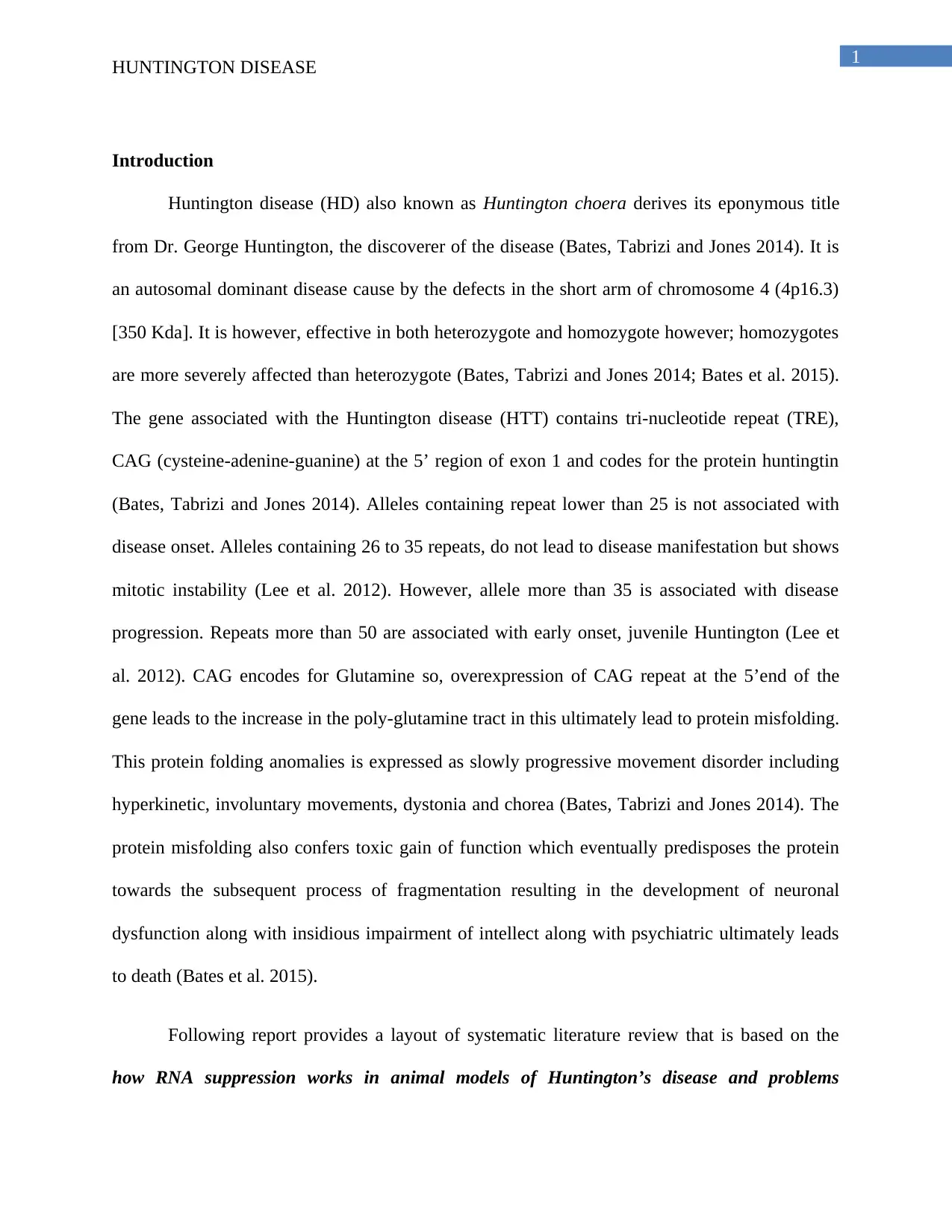
1
HUNTINGTON DISEASE
Introduction
Huntington disease (HD) also known as Huntington choera derives its eponymous title
from Dr. George Huntington, the discoverer of the disease (Bates, Tabrizi and Jones 2014). It is
an autosomal dominant disease cause by the defects in the short arm of chromosome 4 (4p16.3)
[350 Kda]. It is however, effective in both heterozygote and homozygote however; homozygotes
are more severely affected than heterozygote (Bates, Tabrizi and Jones 2014; Bates et al. 2015).
The gene associated with the Huntington disease (HTT) contains tri-nucleotide repeat (TRE),
CAG (cysteine-adenine-guanine) at the 5’ region of exon 1 and codes for the protein huntingtin
(Bates, Tabrizi and Jones 2014). Alleles containing repeat lower than 25 is not associated with
disease onset. Alleles containing 26 to 35 repeats, do not lead to disease manifestation but shows
mitotic instability (Lee et al. 2012). However, allele more than 35 is associated with disease
progression. Repeats more than 50 are associated with early onset, juvenile Huntington (Lee et
al. 2012). CAG encodes for Glutamine so, overexpression of CAG repeat at the 5’end of the
gene leads to the increase in the poly-glutamine tract in this ultimately lead to protein misfolding.
This protein folding anomalies is expressed as slowly progressive movement disorder including
hyperkinetic, involuntary movements, dystonia and chorea (Bates, Tabrizi and Jones 2014). The
protein misfolding also confers toxic gain of function which eventually predisposes the protein
towards the subsequent process of fragmentation resulting in the development of neuronal
dysfunction along with insidious impairment of intellect along with psychiatric ultimately leads
to death (Bates et al. 2015).
Following report provides a layout of systematic literature review that is based on the
how RNA suppression works in animal models of Huntington’s disease and problems
HUNTINGTON DISEASE
Introduction
Huntington disease (HD) also known as Huntington choera derives its eponymous title
from Dr. George Huntington, the discoverer of the disease (Bates, Tabrizi and Jones 2014). It is
an autosomal dominant disease cause by the defects in the short arm of chromosome 4 (4p16.3)
[350 Kda]. It is however, effective in both heterozygote and homozygote however; homozygotes
are more severely affected than heterozygote (Bates, Tabrizi and Jones 2014; Bates et al. 2015).
The gene associated with the Huntington disease (HTT) contains tri-nucleotide repeat (TRE),
CAG (cysteine-adenine-guanine) at the 5’ region of exon 1 and codes for the protein huntingtin
(Bates, Tabrizi and Jones 2014). Alleles containing repeat lower than 25 is not associated with
disease onset. Alleles containing 26 to 35 repeats, do not lead to disease manifestation but shows
mitotic instability (Lee et al. 2012). However, allele more than 35 is associated with disease
progression. Repeats more than 50 are associated with early onset, juvenile Huntington (Lee et
al. 2012). CAG encodes for Glutamine so, overexpression of CAG repeat at the 5’end of the
gene leads to the increase in the poly-glutamine tract in this ultimately lead to protein misfolding.
This protein folding anomalies is expressed as slowly progressive movement disorder including
hyperkinetic, involuntary movements, dystonia and chorea (Bates, Tabrizi and Jones 2014). The
protein misfolding also confers toxic gain of function which eventually predisposes the protein
towards the subsequent process of fragmentation resulting in the development of neuronal
dysfunction along with insidious impairment of intellect along with psychiatric ultimately leads
to death (Bates et al. 2015).
Following report provides a layout of systematic literature review that is based on the
how RNA suppression works in animal models of Huntington’s disease and problems
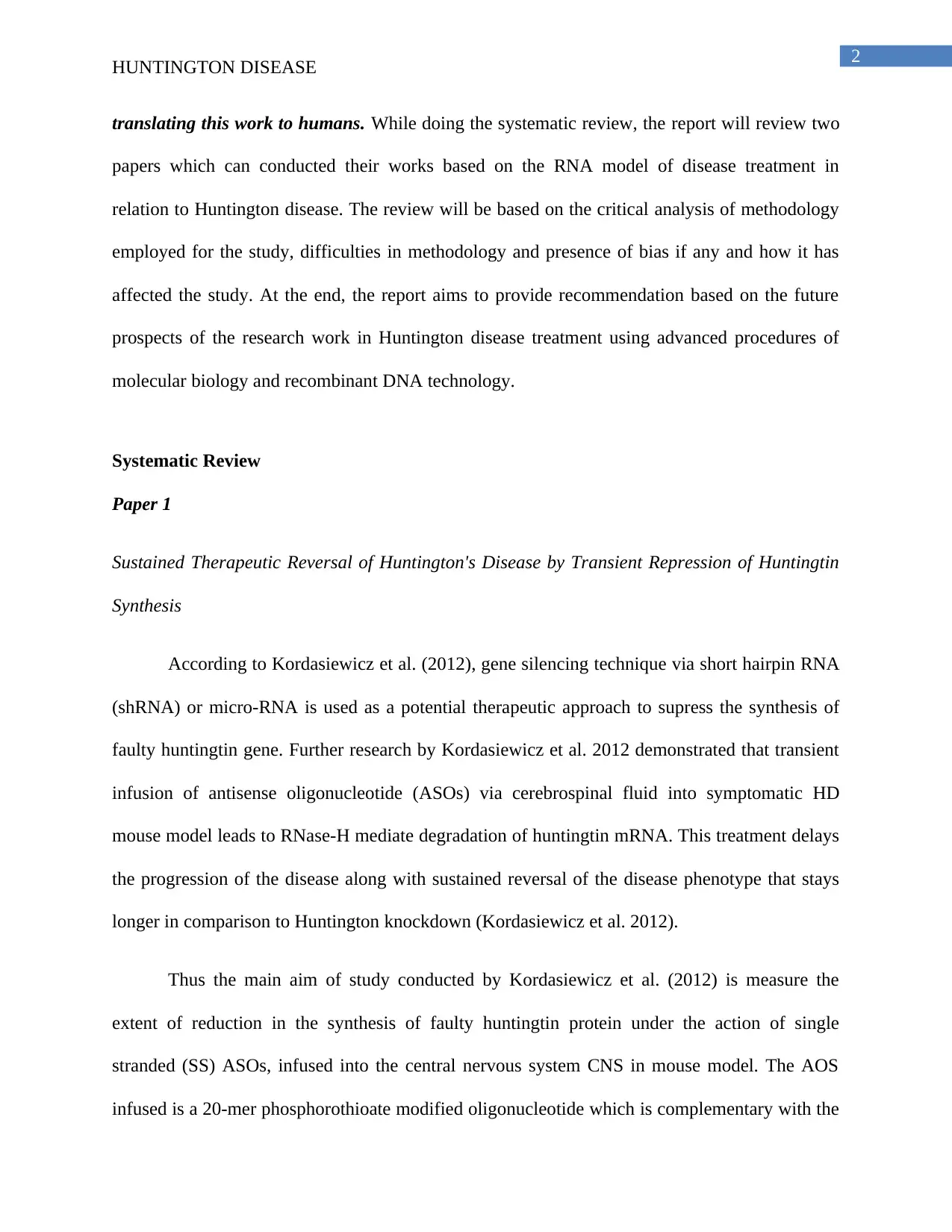
2
HUNTINGTON DISEASE
translating this work to humans. While doing the systematic review, the report will review two
papers which can conducted their works based on the RNA model of disease treatment in
relation to Huntington disease. The review will be based on the critical analysis of methodology
employed for the study, difficulties in methodology and presence of bias if any and how it has
affected the study. At the end, the report aims to provide recommendation based on the future
prospects of the research work in Huntington disease treatment using advanced procedures of
molecular biology and recombinant DNA technology.
Systematic Review
Paper 1
Sustained Therapeutic Reversal of Huntington's Disease by Transient Repression of Huntingtin
Synthesis
According to Kordasiewicz et al. (2012), gene silencing technique via short hairpin RNA
(shRNA) or micro-RNA is used as a potential therapeutic approach to supress the synthesis of
faulty huntingtin gene. Further research by Kordasiewicz et al. 2012 demonstrated that transient
infusion of antisense oligonucleotide (ASOs) via cerebrospinal fluid into symptomatic HD
mouse model leads to RNase-H mediate degradation of huntingtin mRNA. This treatment delays
the progression of the disease along with sustained reversal of the disease phenotype that stays
longer in comparison to Huntington knockdown (Kordasiewicz et al. 2012).
Thus the main aim of study conducted by Kordasiewicz et al. (2012) is measure the
extent of reduction in the synthesis of faulty huntingtin protein under the action of single
stranded (SS) ASOs, infused into the central nervous system CNS in mouse model. The AOS
infused is a 20-mer phosphorothioate modified oligonucleotide which is complementary with the
HUNTINGTON DISEASE
translating this work to humans. While doing the systematic review, the report will review two
papers which can conducted their works based on the RNA model of disease treatment in
relation to Huntington disease. The review will be based on the critical analysis of methodology
employed for the study, difficulties in methodology and presence of bias if any and how it has
affected the study. At the end, the report aims to provide recommendation based on the future
prospects of the research work in Huntington disease treatment using advanced procedures of
molecular biology and recombinant DNA technology.
Systematic Review
Paper 1
Sustained Therapeutic Reversal of Huntington's Disease by Transient Repression of Huntingtin
Synthesis
According to Kordasiewicz et al. (2012), gene silencing technique via short hairpin RNA
(shRNA) or micro-RNA is used as a potential therapeutic approach to supress the synthesis of
faulty huntingtin gene. Further research by Kordasiewicz et al. 2012 demonstrated that transient
infusion of antisense oligonucleotide (ASOs) via cerebrospinal fluid into symptomatic HD
mouse model leads to RNase-H mediate degradation of huntingtin mRNA. This treatment delays
the progression of the disease along with sustained reversal of the disease phenotype that stays
longer in comparison to Huntington knockdown (Kordasiewicz et al. 2012).
Thus the main aim of study conducted by Kordasiewicz et al. (2012) is measure the
extent of reduction in the synthesis of faulty huntingtin protein under the action of single
stranded (SS) ASOs, infused into the central nervous system CNS in mouse model. The AOS
infused is a 20-mer phosphorothioate modified oligonucleotide which is complementary with the
⊘ This is a preview!⊘
Do you want full access?
Subscribe today to unlock all pages.

Trusted by 1+ million students worldwide
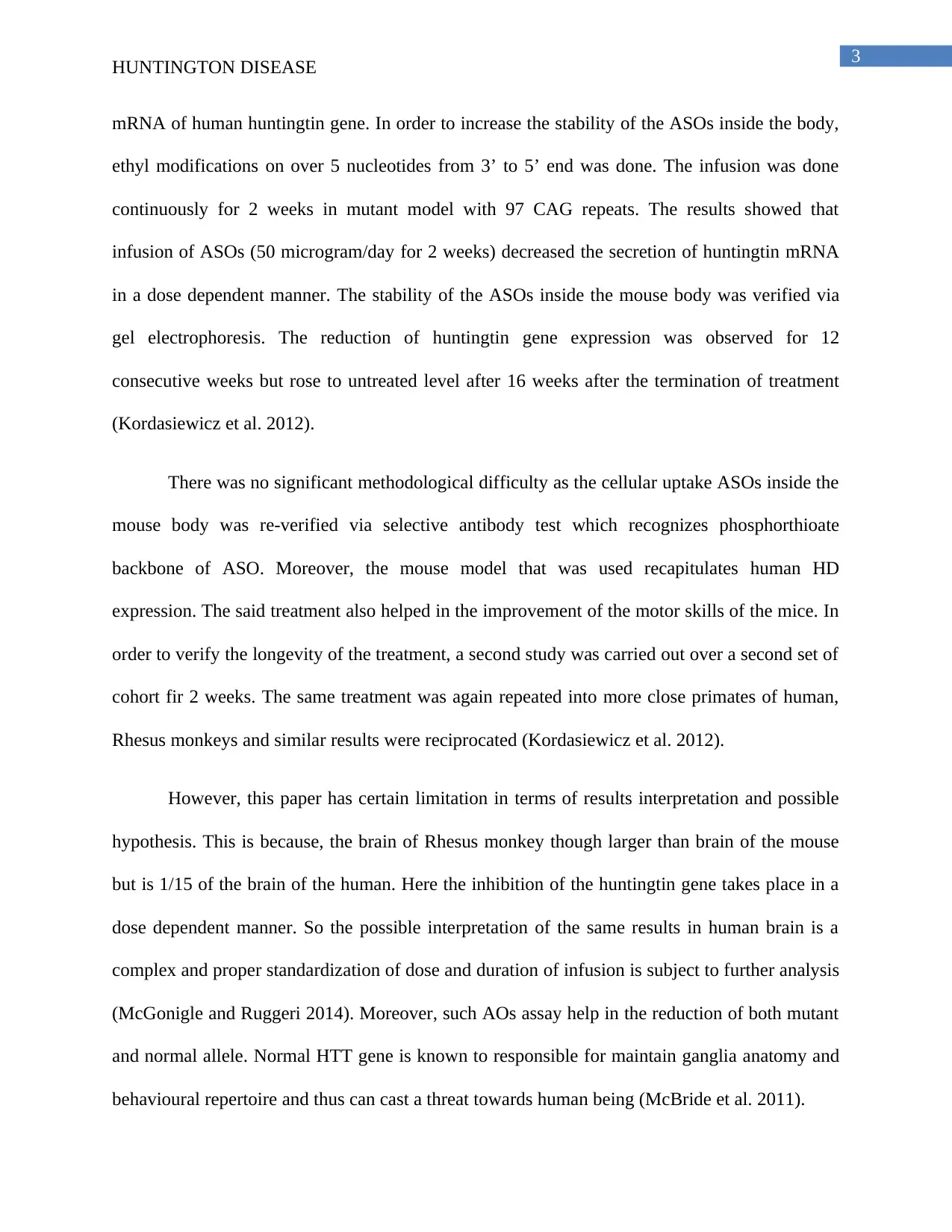
3
HUNTINGTON DISEASE
mRNA of human huntingtin gene. In order to increase the stability of the ASOs inside the body,
ethyl modifications on over 5 nucleotides from 3’ to 5’ end was done. The infusion was done
continuously for 2 weeks in mutant model with 97 CAG repeats. The results showed that
infusion of ASOs (50 microgram/day for 2 weeks) decreased the secretion of huntingtin mRNA
in a dose dependent manner. The stability of the ASOs inside the mouse body was verified via
gel electrophoresis. The reduction of huntingtin gene expression was observed for 12
consecutive weeks but rose to untreated level after 16 weeks after the termination of treatment
(Kordasiewicz et al. 2012).
There was no significant methodological difficulty as the cellular uptake ASOs inside the
mouse body was re-verified via selective antibody test which recognizes phosphorthioate
backbone of ASO. Moreover, the mouse model that was used recapitulates human HD
expression. The said treatment also helped in the improvement of the motor skills of the mice. In
order to verify the longevity of the treatment, a second study was carried out over a second set of
cohort fir 2 weeks. The same treatment was again repeated into more close primates of human,
Rhesus monkeys and similar results were reciprocated (Kordasiewicz et al. 2012).
However, this paper has certain limitation in terms of results interpretation and possible
hypothesis. This is because, the brain of Rhesus monkey though larger than brain of the mouse
but is 1/15 of the brain of the human. Here the inhibition of the huntingtin gene takes place in a
dose dependent manner. So the possible interpretation of the same results in human brain is a
complex and proper standardization of dose and duration of infusion is subject to further analysis
(McGonigle and Ruggeri 2014). Moreover, such AOs assay help in the reduction of both mutant
and normal allele. Normal HTT gene is known to responsible for maintain ganglia anatomy and
behavioural repertoire and thus can cast a threat towards human being (McBride et al. 2011).
HUNTINGTON DISEASE
mRNA of human huntingtin gene. In order to increase the stability of the ASOs inside the body,
ethyl modifications on over 5 nucleotides from 3’ to 5’ end was done. The infusion was done
continuously for 2 weeks in mutant model with 97 CAG repeats. The results showed that
infusion of ASOs (50 microgram/day for 2 weeks) decreased the secretion of huntingtin mRNA
in a dose dependent manner. The stability of the ASOs inside the mouse body was verified via
gel electrophoresis. The reduction of huntingtin gene expression was observed for 12
consecutive weeks but rose to untreated level after 16 weeks after the termination of treatment
(Kordasiewicz et al. 2012).
There was no significant methodological difficulty as the cellular uptake ASOs inside the
mouse body was re-verified via selective antibody test which recognizes phosphorthioate
backbone of ASO. Moreover, the mouse model that was used recapitulates human HD
expression. The said treatment also helped in the improvement of the motor skills of the mice. In
order to verify the longevity of the treatment, a second study was carried out over a second set of
cohort fir 2 weeks. The same treatment was again repeated into more close primates of human,
Rhesus monkeys and similar results were reciprocated (Kordasiewicz et al. 2012).
However, this paper has certain limitation in terms of results interpretation and possible
hypothesis. This is because, the brain of Rhesus monkey though larger than brain of the mouse
but is 1/15 of the brain of the human. Here the inhibition of the huntingtin gene takes place in a
dose dependent manner. So the possible interpretation of the same results in human brain is a
complex and proper standardization of dose and duration of infusion is subject to further analysis
(McGonigle and Ruggeri 2014). Moreover, such AOs assay help in the reduction of both mutant
and normal allele. Normal HTT gene is known to responsible for maintain ganglia anatomy and
behavioural repertoire and thus can cast a threat towards human being (McBride et al. 2011).
Paraphrase This Document
Need a fresh take? Get an instant paraphrase of this document with our AI Paraphraser
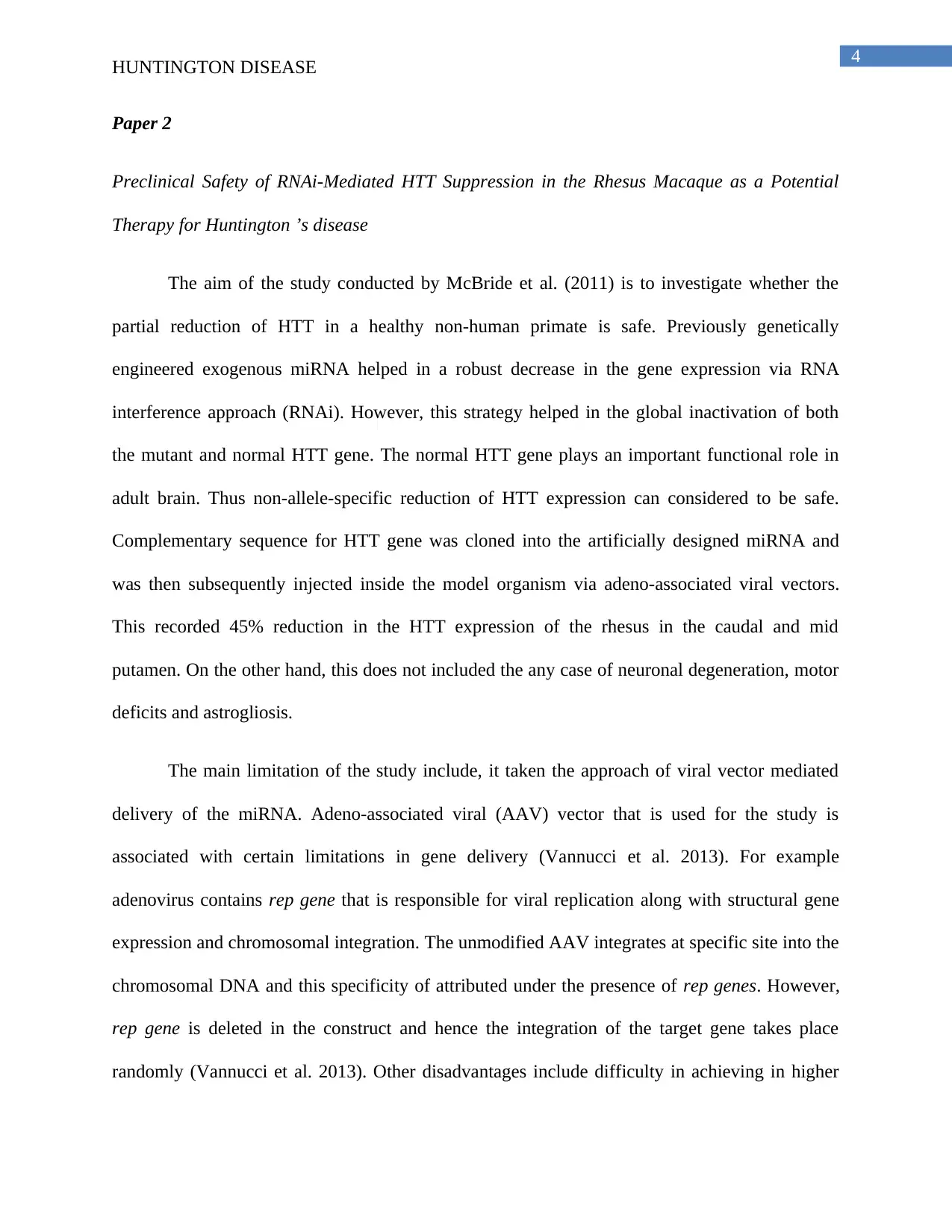
4
HUNTINGTON DISEASE
Paper 2
Preclinical Safety of RNAi-Mediated HTT Suppression in the Rhesus Macaque as a Potential
Therapy for Huntington ’s disease
The aim of the study conducted by McBride et al. (2011) is to investigate whether the
partial reduction of HTT in a healthy non-human primate is safe. Previously genetically
engineered exogenous miRNA helped in a robust decrease in the gene expression via RNA
interference approach (RNAi). However, this strategy helped in the global inactivation of both
the mutant and normal HTT gene. The normal HTT gene plays an important functional role in
adult brain. Thus non-allele-specific reduction of HTT expression can considered to be safe.
Complementary sequence for HTT gene was cloned into the artificially designed miRNA and
was then subsequently injected inside the model organism via adeno-associated viral vectors.
This recorded 45% reduction in the HTT expression of the rhesus in the caudal and mid
putamen. On the other hand, this does not included the any case of neuronal degeneration, motor
deficits and astrogliosis.
The main limitation of the study include, it taken the approach of viral vector mediated
delivery of the miRNA. Adeno-associated viral (AAV) vector that is used for the study is
associated with certain limitations in gene delivery (Vannucci et al. 2013). For example
adenovirus contains rep gene that is responsible for viral replication along with structural gene
expression and chromosomal integration. The unmodified AAV integrates at specific site into the
chromosomal DNA and this specificity of attributed under the presence of rep genes. However,
rep gene is deleted in the construct and hence the integration of the target gene takes place
randomly (Vannucci et al. 2013). Other disadvantages include difficulty in achieving in higher
HUNTINGTON DISEASE
Paper 2
Preclinical Safety of RNAi-Mediated HTT Suppression in the Rhesus Macaque as a Potential
Therapy for Huntington ’s disease
The aim of the study conducted by McBride et al. (2011) is to investigate whether the
partial reduction of HTT in a healthy non-human primate is safe. Previously genetically
engineered exogenous miRNA helped in a robust decrease in the gene expression via RNA
interference approach (RNAi). However, this strategy helped in the global inactivation of both
the mutant and normal HTT gene. The normal HTT gene plays an important functional role in
adult brain. Thus non-allele-specific reduction of HTT expression can considered to be safe.
Complementary sequence for HTT gene was cloned into the artificially designed miRNA and
was then subsequently injected inside the model organism via adeno-associated viral vectors.
This recorded 45% reduction in the HTT expression of the rhesus in the caudal and mid
putamen. On the other hand, this does not included the any case of neuronal degeneration, motor
deficits and astrogliosis.
The main limitation of the study include, it taken the approach of viral vector mediated
delivery of the miRNA. Adeno-associated viral (AAV) vector that is used for the study is
associated with certain limitations in gene delivery (Vannucci et al. 2013). For example
adenovirus contains rep gene that is responsible for viral replication along with structural gene
expression and chromosomal integration. The unmodified AAV integrates at specific site into the
chromosomal DNA and this specificity of attributed under the presence of rep genes. However,
rep gene is deleted in the construct and hence the integration of the target gene takes place
randomly (Vannucci et al. 2013). Other disadvantages include difficulty in achieving in higher
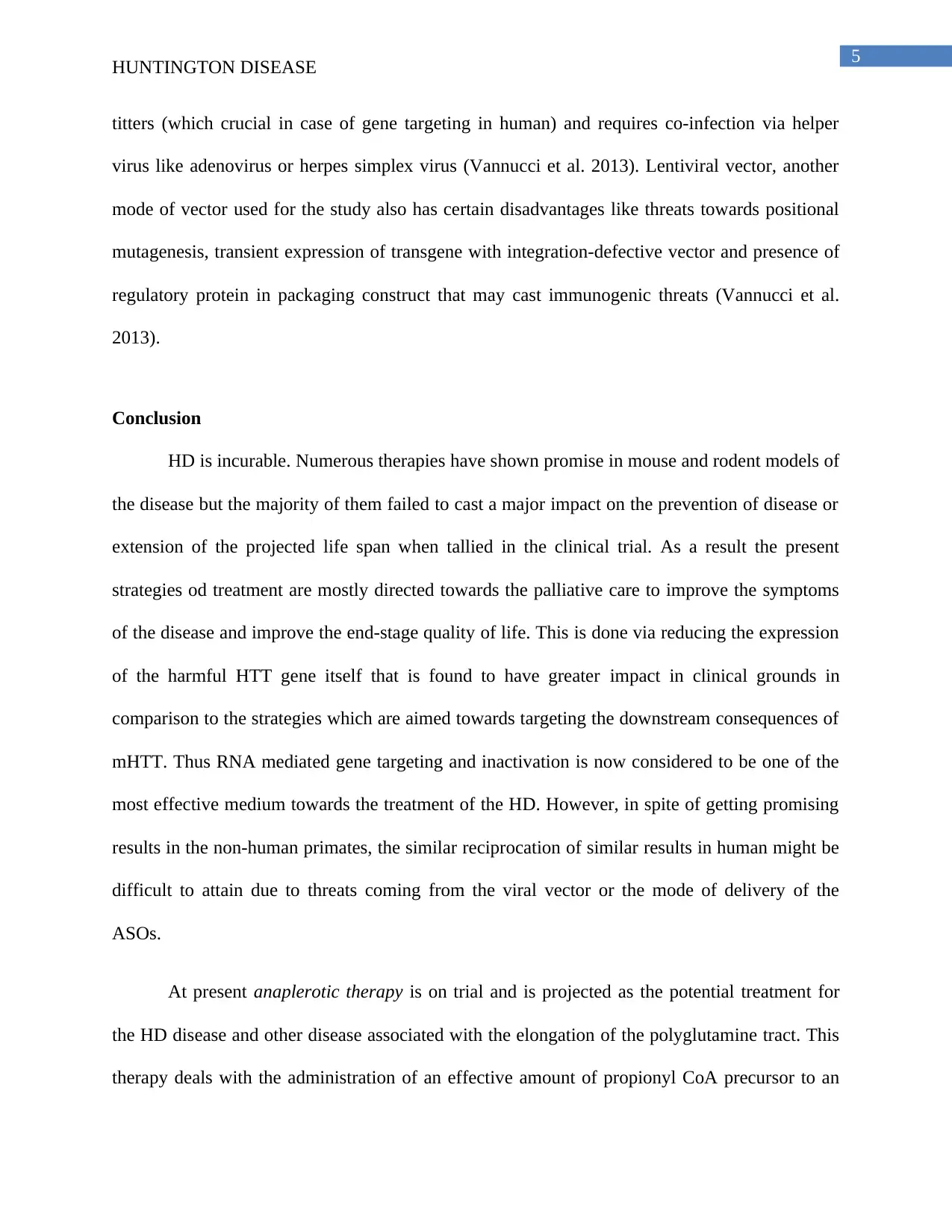
5
HUNTINGTON DISEASE
titters (which crucial in case of gene targeting in human) and requires co-infection via helper
virus like adenovirus or herpes simplex virus (Vannucci et al. 2013). Lentiviral vector, another
mode of vector used for the study also has certain disadvantages like threats towards positional
mutagenesis, transient expression of transgene with integration-defective vector and presence of
regulatory protein in packaging construct that may cast immunogenic threats (Vannucci et al.
2013).
Conclusion
HD is incurable. Numerous therapies have shown promise in mouse and rodent models of
the disease but the majority of them failed to cast a major impact on the prevention of disease or
extension of the projected life span when tallied in the clinical trial. As a result the present
strategies od treatment are mostly directed towards the palliative care to improve the symptoms
of the disease and improve the end-stage quality of life. This is done via reducing the expression
of the harmful HTT gene itself that is found to have greater impact in clinical grounds in
comparison to the strategies which are aimed towards targeting the downstream consequences of
mHTT. Thus RNA mediated gene targeting and inactivation is now considered to be one of the
most effective medium towards the treatment of the HD. However, in spite of getting promising
results in the non-human primates, the similar reciprocation of similar results in human might be
difficult to attain due to threats coming from the viral vector or the mode of delivery of the
ASOs.
At present anaplerotic therapy is on trial and is projected as the potential treatment for
the HD disease and other disease associated with the elongation of the polyglutamine tract. This
therapy deals with the administration of an effective amount of propionyl CoA precursor to an
HUNTINGTON DISEASE
titters (which crucial in case of gene targeting in human) and requires co-infection via helper
virus like adenovirus or herpes simplex virus (Vannucci et al. 2013). Lentiviral vector, another
mode of vector used for the study also has certain disadvantages like threats towards positional
mutagenesis, transient expression of transgene with integration-defective vector and presence of
regulatory protein in packaging construct that may cast immunogenic threats (Vannucci et al.
2013).
Conclusion
HD is incurable. Numerous therapies have shown promise in mouse and rodent models of
the disease but the majority of them failed to cast a major impact on the prevention of disease or
extension of the projected life span when tallied in the clinical trial. As a result the present
strategies od treatment are mostly directed towards the palliative care to improve the symptoms
of the disease and improve the end-stage quality of life. This is done via reducing the expression
of the harmful HTT gene itself that is found to have greater impact in clinical grounds in
comparison to the strategies which are aimed towards targeting the downstream consequences of
mHTT. Thus RNA mediated gene targeting and inactivation is now considered to be one of the
most effective medium towards the treatment of the HD. However, in spite of getting promising
results in the non-human primates, the similar reciprocation of similar results in human might be
difficult to attain due to threats coming from the viral vector or the mode of delivery of the
ASOs.
At present anaplerotic therapy is on trial and is projected as the potential treatment for
the HD disease and other disease associated with the elongation of the polyglutamine tract. This
therapy deals with the administration of an effective amount of propionyl CoA precursor to an
⊘ This is a preview!⊘
Do you want full access?
Subscribe today to unlock all pages.

Trusted by 1+ million students worldwide
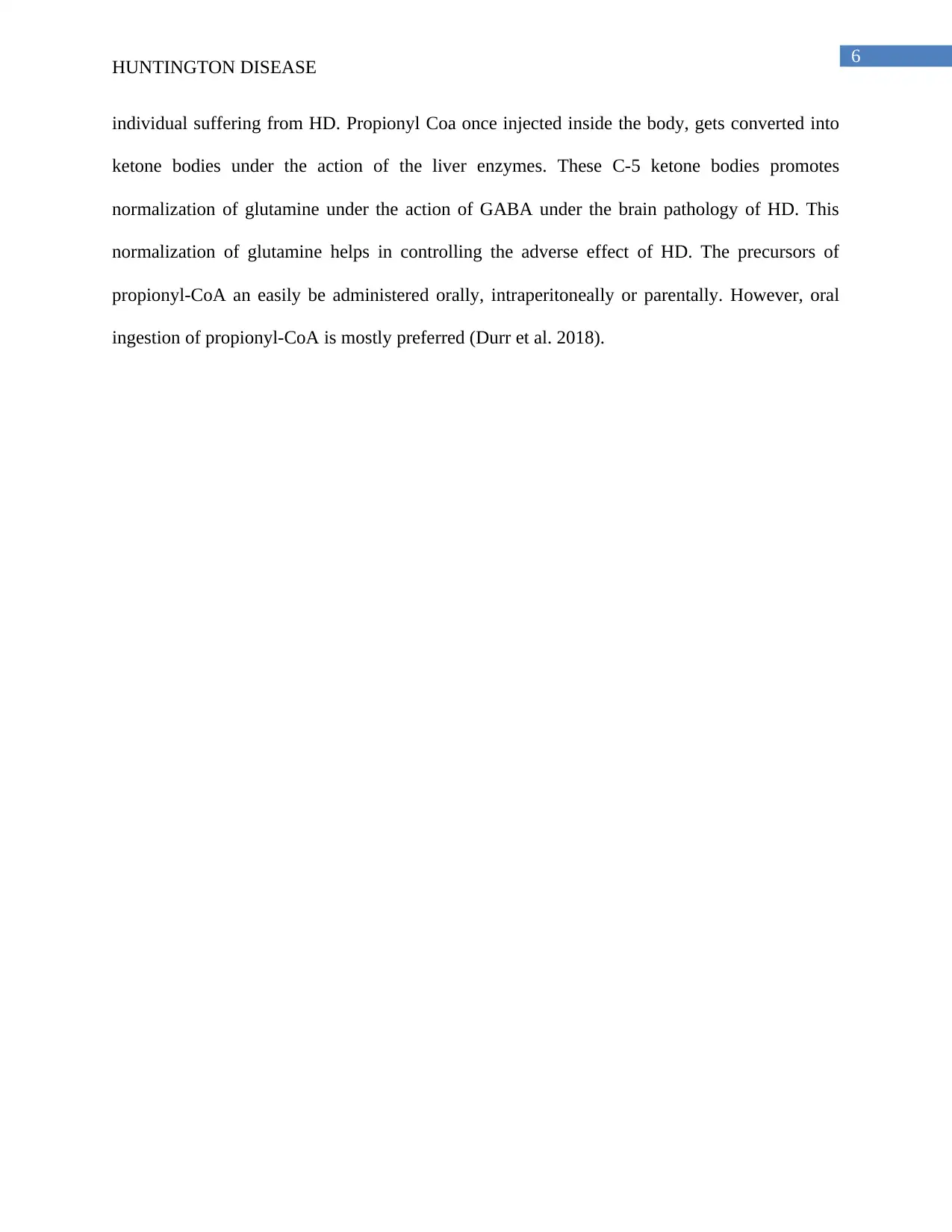
6
HUNTINGTON DISEASE
individual suffering from HD. Propionyl Coa once injected inside the body, gets converted into
ketone bodies under the action of the liver enzymes. These C-5 ketone bodies promotes
normalization of glutamine under the action of GABA under the brain pathology of HD. This
normalization of glutamine helps in controlling the adverse effect of HD. The precursors of
propionyl-CoA an easily be administered orally, intraperitoneally or parentally. However, oral
ingestion of propionyl-CoA is mostly preferred (Durr et al. 2018).
HUNTINGTON DISEASE
individual suffering from HD. Propionyl Coa once injected inside the body, gets converted into
ketone bodies under the action of the liver enzymes. These C-5 ketone bodies promotes
normalization of glutamine under the action of GABA under the brain pathology of HD. This
normalization of glutamine helps in controlling the adverse effect of HD. The precursors of
propionyl-CoA an easily be administered orally, intraperitoneally or parentally. However, oral
ingestion of propionyl-CoA is mostly preferred (Durr et al. 2018).
Paraphrase This Document
Need a fresh take? Get an instant paraphrase of this document with our AI Paraphraser
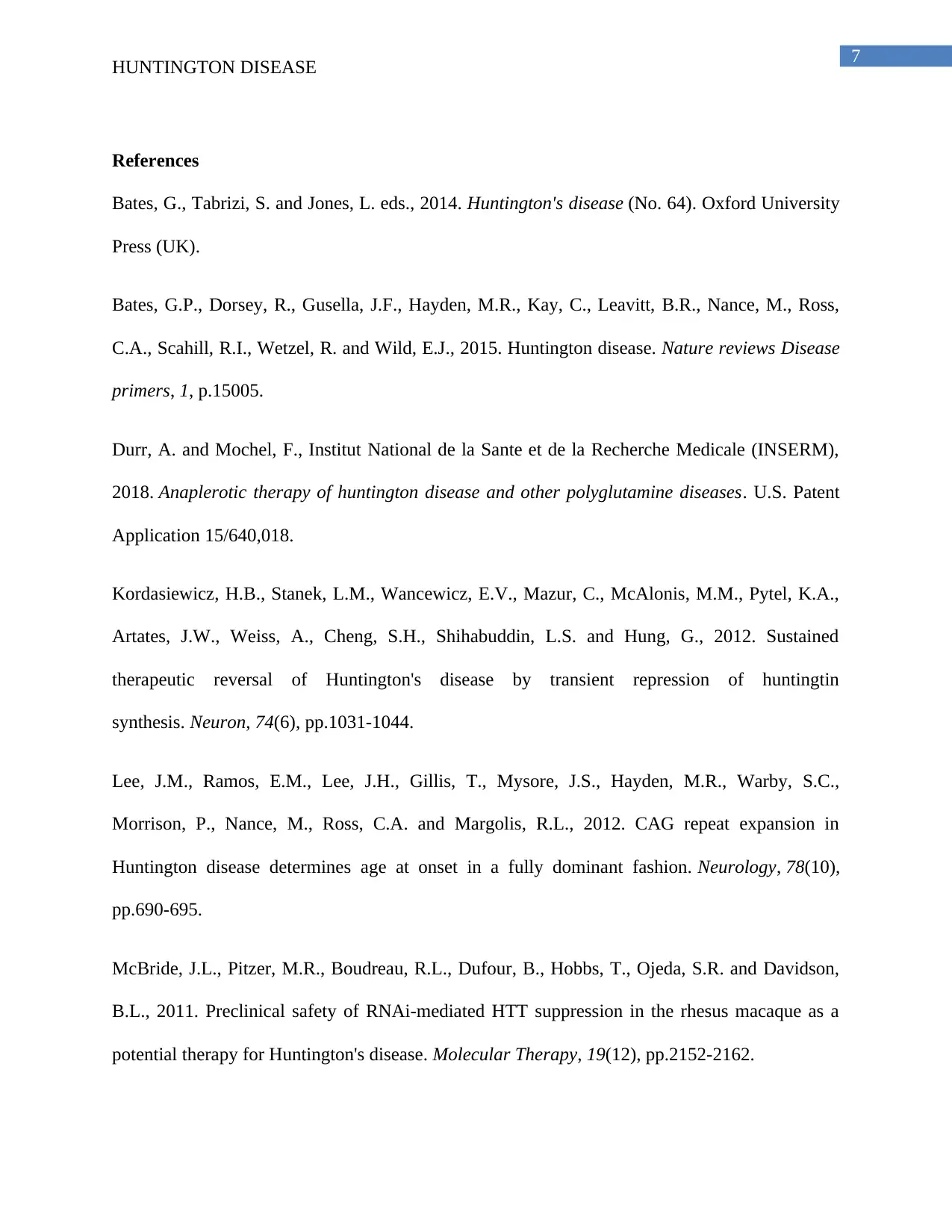
7
HUNTINGTON DISEASE
References
Bates, G., Tabrizi, S. and Jones, L. eds., 2014. Huntington's disease (No. 64). Oxford University
Press (UK).
Bates, G.P., Dorsey, R., Gusella, J.F., Hayden, M.R., Kay, C., Leavitt, B.R., Nance, M., Ross,
C.A., Scahill, R.I., Wetzel, R. and Wild, E.J., 2015. Huntington disease. Nature reviews Disease
primers, 1, p.15005.
Durr, A. and Mochel, F., Institut National de la Sante et de la Recherche Medicale (INSERM),
2018. Anaplerotic therapy of huntington disease and other polyglutamine diseases. U.S. Patent
Application 15/640,018.
Kordasiewicz, H.B., Stanek, L.M., Wancewicz, E.V., Mazur, C., McAlonis, M.M., Pytel, K.A.,
Artates, J.W., Weiss, A., Cheng, S.H., Shihabuddin, L.S. and Hung, G., 2012. Sustained
therapeutic reversal of Huntington's disease by transient repression of huntingtin
synthesis. Neuron, 74(6), pp.1031-1044.
Lee, J.M., Ramos, E.M., Lee, J.H., Gillis, T., Mysore, J.S., Hayden, M.R., Warby, S.C.,
Morrison, P., Nance, M., Ross, C.A. and Margolis, R.L., 2012. CAG repeat expansion in
Huntington disease determines age at onset in a fully dominant fashion. Neurology, 78(10),
pp.690-695.
McBride, J.L., Pitzer, M.R., Boudreau, R.L., Dufour, B., Hobbs, T., Ojeda, S.R. and Davidson,
B.L., 2011. Preclinical safety of RNAi-mediated HTT suppression in the rhesus macaque as a
potential therapy for Huntington's disease. Molecular Therapy, 19(12), pp.2152-2162.
HUNTINGTON DISEASE
References
Bates, G., Tabrizi, S. and Jones, L. eds., 2014. Huntington's disease (No. 64). Oxford University
Press (UK).
Bates, G.P., Dorsey, R., Gusella, J.F., Hayden, M.R., Kay, C., Leavitt, B.R., Nance, M., Ross,
C.A., Scahill, R.I., Wetzel, R. and Wild, E.J., 2015. Huntington disease. Nature reviews Disease
primers, 1, p.15005.
Durr, A. and Mochel, F., Institut National de la Sante et de la Recherche Medicale (INSERM),
2018. Anaplerotic therapy of huntington disease and other polyglutamine diseases. U.S. Patent
Application 15/640,018.
Kordasiewicz, H.B., Stanek, L.M., Wancewicz, E.V., Mazur, C., McAlonis, M.M., Pytel, K.A.,
Artates, J.W., Weiss, A., Cheng, S.H., Shihabuddin, L.S. and Hung, G., 2012. Sustained
therapeutic reversal of Huntington's disease by transient repression of huntingtin
synthesis. Neuron, 74(6), pp.1031-1044.
Lee, J.M., Ramos, E.M., Lee, J.H., Gillis, T., Mysore, J.S., Hayden, M.R., Warby, S.C.,
Morrison, P., Nance, M., Ross, C.A. and Margolis, R.L., 2012. CAG repeat expansion in
Huntington disease determines age at onset in a fully dominant fashion. Neurology, 78(10),
pp.690-695.
McBride, J.L., Pitzer, M.R., Boudreau, R.L., Dufour, B., Hobbs, T., Ojeda, S.R. and Davidson,
B.L., 2011. Preclinical safety of RNAi-mediated HTT suppression in the rhesus macaque as a
potential therapy for Huntington's disease. Molecular Therapy, 19(12), pp.2152-2162.

8
HUNTINGTON DISEASE
McGonigle, P. and Ruggeri, B., 2014. Animal models of human disease: challenges in enabling
translation. Biochemical pharmacology, 87(1), pp.162-171.
Vannucci, L., Lai, M., Chiuppesi, F., Ceccherini-Nelli, L. and Pistello, M., 2013. Viral vectors: a
look back and ahead on gene transfer technology. New Microbiol, 36(1), pp.1-22.
HUNTINGTON DISEASE
McGonigle, P. and Ruggeri, B., 2014. Animal models of human disease: challenges in enabling
translation. Biochemical pharmacology, 87(1), pp.162-171.
Vannucci, L., Lai, M., Chiuppesi, F., Ceccherini-Nelli, L. and Pistello, M., 2013. Viral vectors: a
look back and ahead on gene transfer technology. New Microbiol, 36(1), pp.1-22.
⊘ This is a preview!⊘
Do you want full access?
Subscribe today to unlock all pages.

Trusted by 1+ million students worldwide
1 out of 9
Your All-in-One AI-Powered Toolkit for Academic Success.
+13062052269
info@desklib.com
Available 24*7 on WhatsApp / Email
![[object Object]](/_next/static/media/star-bottom.7253800d.svg)
Unlock your academic potential
Copyright © 2020–2025 A2Z Services. All Rights Reserved. Developed and managed by ZUCOL.